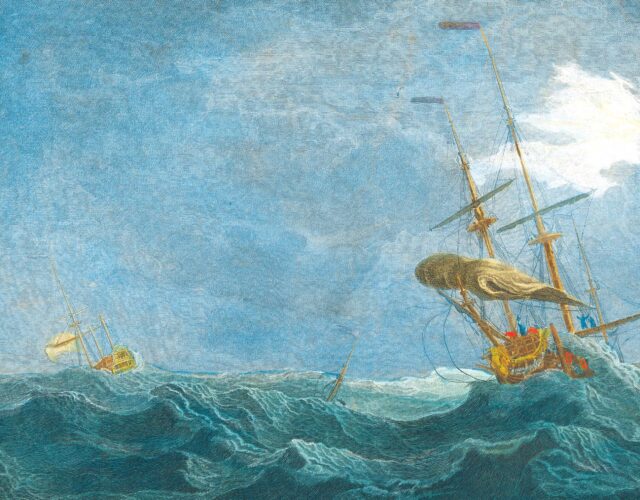One summer evening in 1808, while on a stroll through London with his wife and sister-in-law, sailor Thomas Urquhart was accosted by a stranger who wanted to know his name. As the outraged Urquhart demanded to know by what right the man questioned him, three or four men seized him, smacked him on the head, and dragged him along the street. They “tore my coat from my back, and afterwards [pulled] me by the neck for fifty yards, until life was nearly exhausted,” wrote Urquhart in a letter that described the assault.
Fortunately for Urquhart passersby intervened, and the attackers fled. But unfortunately Urquhart’s experience was far from unique. In the 18th and early 19th centuries fishermen and merchant seamen like Urquhart lived in fear of “press gangs,” groups of ruffians who roamed the nighttime streets, searching for victims to “impress” into the British navy. Whether English, Irish, American, or Canadian, any subject of the British Empire with seafaring experience was vulnerable to abduction.
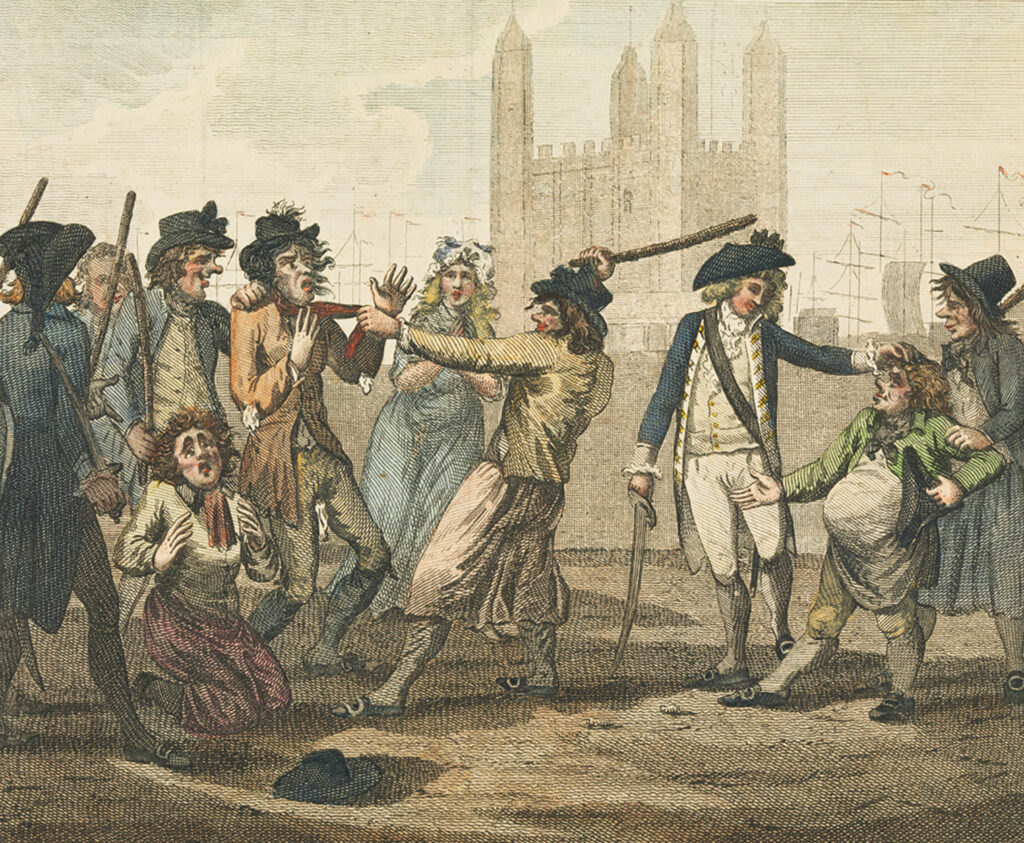
If the gang that attacked Urquhart had succeeded, he likely would have awoken trapped on a ship and with nearly no hope of escape. By the time he returned home—if he returned home—he would have endured storms, battles, fevers, and years away from family and friends. But of all the horrors faced by sailors at the time, one of the greatest threats had nothing to do with pirates or wars or weather. It had to do with food.
Scurvy killed more than two million sailors between the time of Columbus’s transatlantic voyage and the rise of steam engines in the mid-19th century. The problem was so common that shipowners and governments assumed a 50% death rate from scurvy for their sailors on any major voyage. According to historian Stephen Bown scurvy was responsible for more deaths at sea than storms, shipwrecks, combat, and all other diseases combined. In fact, scurvy was so devastating that the search for a cure became what Bown describes as “a vital factor determining the destiny of nations.”
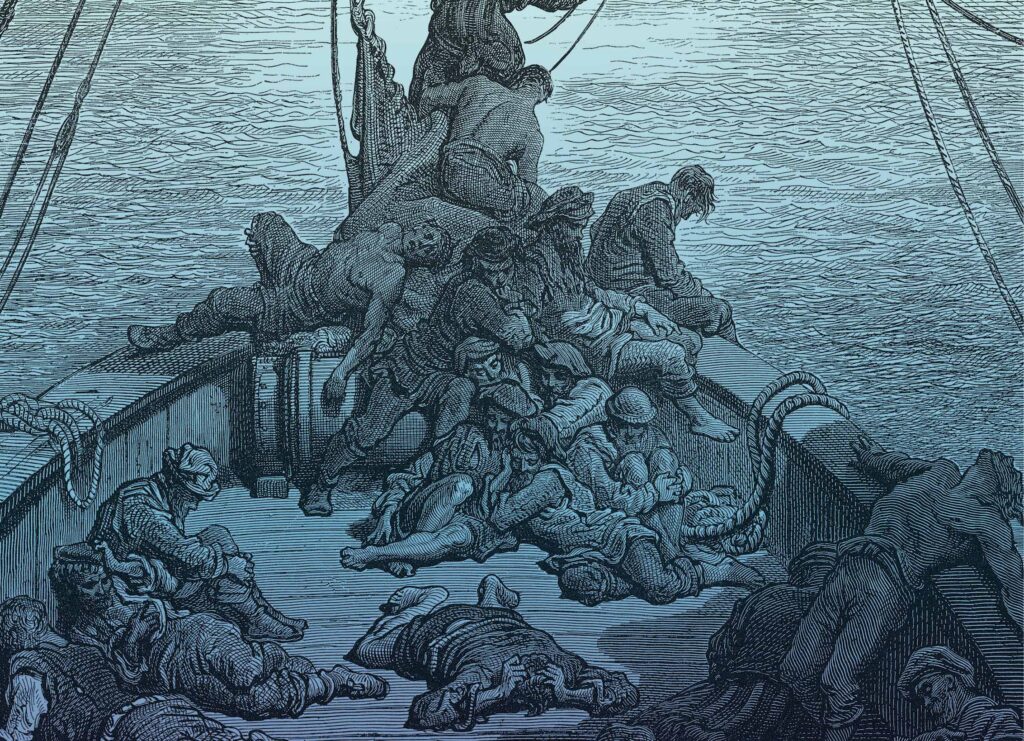
None of the potential fates awaiting sailors was pleasant, but scurvy exacted a particularly gruesome death. The earliest symptom—lethargy so intense that people once believed laziness was a cause of the disease—is debilitating. Your body feels weak. Your joints ache. Your arms and legs swell, and your skin bruises at the slightest touch. As the disease progresses, your gums become spongy and your breath fetid, your teeth loosen, and internal hemorrhaging makes splotches on your skin. Old wounds open; mucous membranes bleed. Left untreated, you will die, likely from a sudden hemorrhage near your heart or brain.
Bown quotes a survival story written by an unknown surgeon on a 16th-century English voyage that reveals the horror of the disease:
Scurvy affected many of the explorers we learned about in grade school: Vasco da Gama lost his brother to it; Ferdinand Magellan watched it kill many of his men, who had nothing to eat, he wrote, but “old biscuit reduced to powder, and full of grubs, and stinking from the dirt which the rats had made on it when eating the good biscuit.” The most famous scurvy-related disaster, however—and the one that fully captures the enduring importance of the tart substance we call vitamin C—was the ill-fated voyage of George Anson, whose 1740–1744 circumnavigation of the globe was the scene of one of the worst medical disasters at sea.
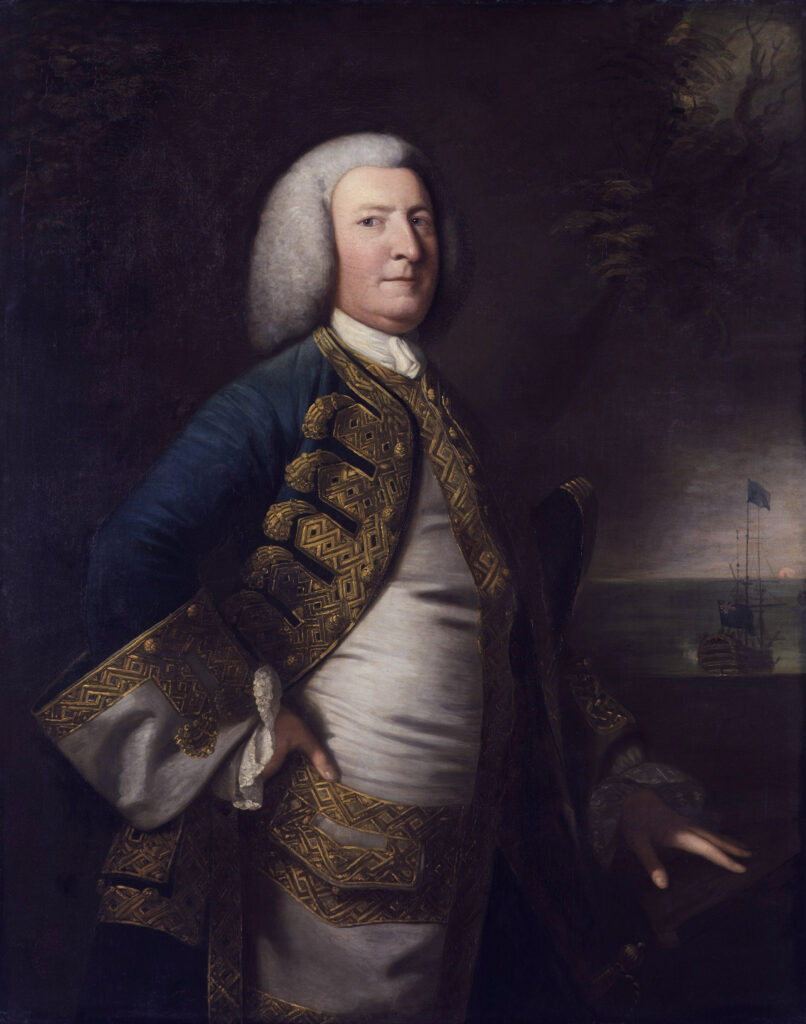
In late 1739 England and Spain declared war to determine control of the Caribbean. Anson, a British captain who had recently returned from the West Indies, was put in charge of a six-ship mission to the Pacific coast of South America, an area important to Spanish trade. In an official portrait Anson’s round face, pursed lips, and feminine curls make him look more like a grandmother than a ship’s captain. But if Anson’s countenance was placid, the task that lay ahead of him was far from pleasant. First, he was to aggravate the Spaniards as much as possible by attacking vulnerable Spanish towns and destroying or capturing any Spanish ships he could find. Second, he was to track down and capture one of the Spanish treasure galleons that transported silver from Acapulco to Manila in the Philippines. Such a ship was so valuable it was known as the “Prize of all the Oceans.”
Anson began his preparations in February 1740, and problems arose from the start. The ships assigned to Anson needed to be repaired and refitted for his mission, a task that would take months. The bigger challenge, however, was finding sailors since the Royal Navy was snatching up for military service all the able-bodied men it could find—often through press gangs like the one Thomas Urquhart encountered in 1808.
Anson’s mission was low on the navy’s priority list, and even the press gangs couldn’t supply him with a sufficient crew: he was supposed to sail with 2,000 men, but by July 1740 he was still a couple hundred short.
The Royal Navy, eager to make room for wounded sailors from the war, eventually came up with both a clever and horrifying solution: it emptied out a hospital, Chelsea Hospital to be exact, which was home to war veterans who were so old, wounded, crippled, or mentally unsound they could no longer serve in marching regiments. Making things worse, those recruits who were relatively healthy did something quite rational: on their release from the hospital they simply walked away. As Anson’s chaplain, Richard Walter, later wrote in the voyage’s official account, this left behind “only such as were literally invalids, most of them being sixty years of age, and some of them upwards of seventy.” To make up for the 240-odd quasicompetent invalids (out of an initial 500) who had limped off, the navy supplied Anson with 210 young marines, so inexperienced and untrained, wrote Walter, that they had never even been permitted to fire their guns.
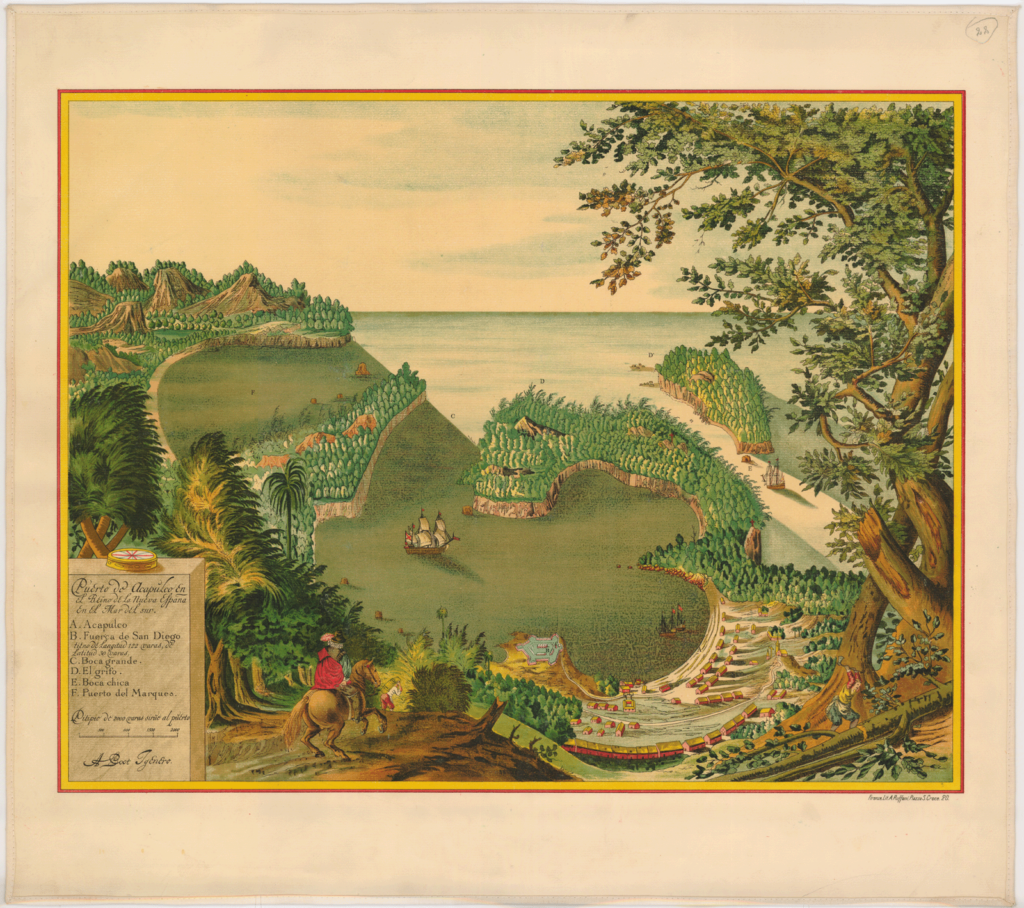
The six ships and their ragtag crews finally set sail in September after some six months of preparation and—since they’d survived on ship rations while waiting to depart—months without access to fresh fruits and vegetables. Already weakened by some combination of age, sickness, war wounds, and malnourishment, Anson’s crew was likely terrified of what lay ahead: years at sea, deliberately seeking out conflict wherever they could find it. But what they should have feared the most was not Spanish warships but what sailors at the time called “the Scurvy.”
Aware of that risk, the navy issued Anson’s crew several of the most popular treatments of the day: vinegar, “elixir of vitriol” (a mixture of sulfuric acid and alcohol), and a patent medicine called Ward’s Drop and Pill, which was known less for its curative abilities than for its laxative effects. While all the treatments were universally unpleasant, none did a thing to prevent scurvy. As the months wore on, the men’s vulnerability increased.
The disease hit at the worst possible time, while the ships were rounding Cape Horn, a turbulent stretch of ocean at the tip of South America. On March 7, 1741, once the squadron passed successfully through the straits that were considered the boundary between the Atlantic and Pacific Oceans, Walter optimistically reported that “we could not help flattering ourselves that the greatest difficulty of our passage was now at an end.” The sky was clear; the weather was calm; the men’s spirits were high. But their optimism was unfounded. March 7 was, says Walter, “the last cheerful day that the greatest part of us would ever live to enjoy.”
Suddenly the sky blackened, and the winds shifted. As the ships were pushed off course, the water began to churn with waves so mountainous that if one had broken over a ship, wrote Walter, it would “in all probability have sent us to the bottom.” The southern hemisphere’s autumn storms had begun—and once they started, they raged for months. It rained. It snowed. It hailed. Men got frostbite. In a moment that haunted witnesses for years, one of Anson’s best sailors was tossed into the water and continued to swim strongly alongside the ship, his comrades watching helplessly, until he was finally lost in the waves. Much of the mainsail of Anson’s ship, the Centurion, was blown overboard; the ship itself was so damaged by the buffeting waves that it leaked water at every seam.
These storms lasted for an inconceivable three months. By the time the weather finally broke in late May, two of Anson’s ships had given up and turned back, and the remainder had been separated, unaware of whether the other ships had survived. The hospital pensioners and most of the young marines were dead.
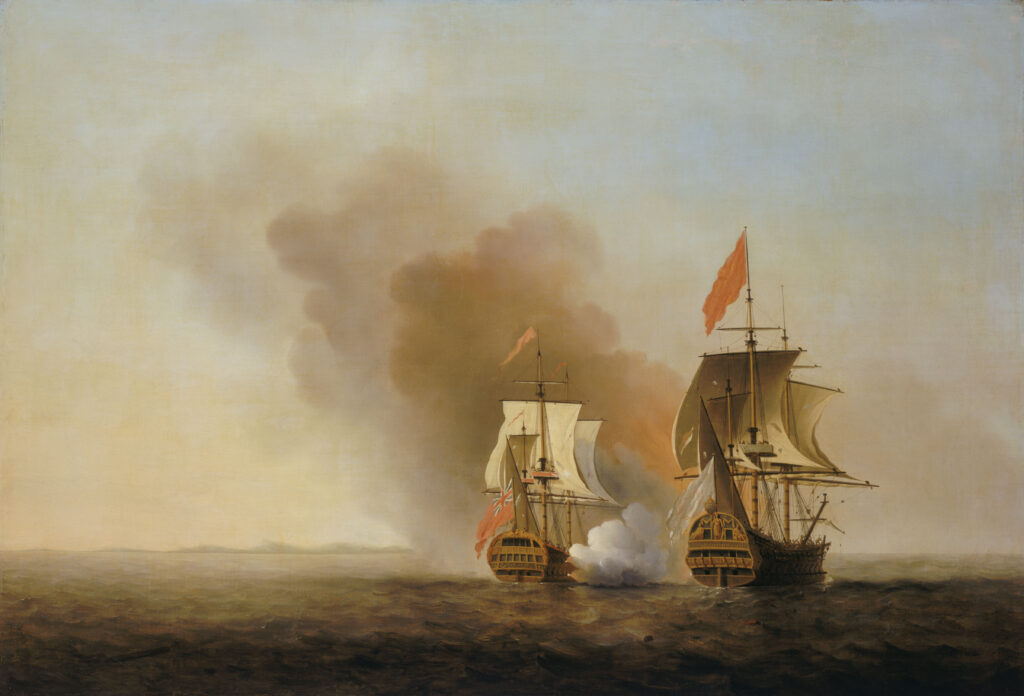
The storms were a horrific challenge, but scurvy proved even more destructive than the gales. “At the latter end of April, there were but a few on board who were not in some degree afflicted with it,” wrote Walter, “and in that month no less than forty-three died of it on board the Centurion.” In May that number doubled. As the number of men above deck dwindled, the scene below grew ever worse: sick men with open sores and rotting wounds swaying in tightly packed hammocks above a sloshing, rat-infested floor. Victims developed discolored spots all over their bodies, their legs swelled, and if they exerted themselves in even the tiniest degree—or were simply moved by someone else—they were apt to swoon and die immediately. When they did, they often remained right where they were since the remaining crew was too weak to throw their bodies overboard.
“This disease so frequently attending long voyages, and so particularly destructive to us, is surely the most singular and unaccountable of any that afflicts the human body,” Walter later wrote. It did things that he admitted sound “scarcely credible.” One dying sailor who had been wounded 50 years earlier watched in horror as his wounds “broke out afresh, and appeared as if they had never been healed.” Later, “the callous of a broken bone, which had been completely formed for a long time, was found to be hereby dissolved, and the fracture seemed as if it had never been consolidated.”
Anson and his subordinates had agreed that in case they were separated, they would rendezvous at Juan Fernández Island, a buccaneer hideout located several hundred miles off the Chilean coast due west of Santiago. Despite sickness and storms the Centurion finally reached the island in June and was eventually joined by the expedition’s two remaining ships: the Gloucester and the appropriately named Tryal. By that point the Centurion had only 70 men who were well enough to sail; the Gloucester and the Tryal had each lost more than half of their crews, mostly to scurvy. Out of the 1,200 or so men who would have originally been on the three ships, only 335 had survived.
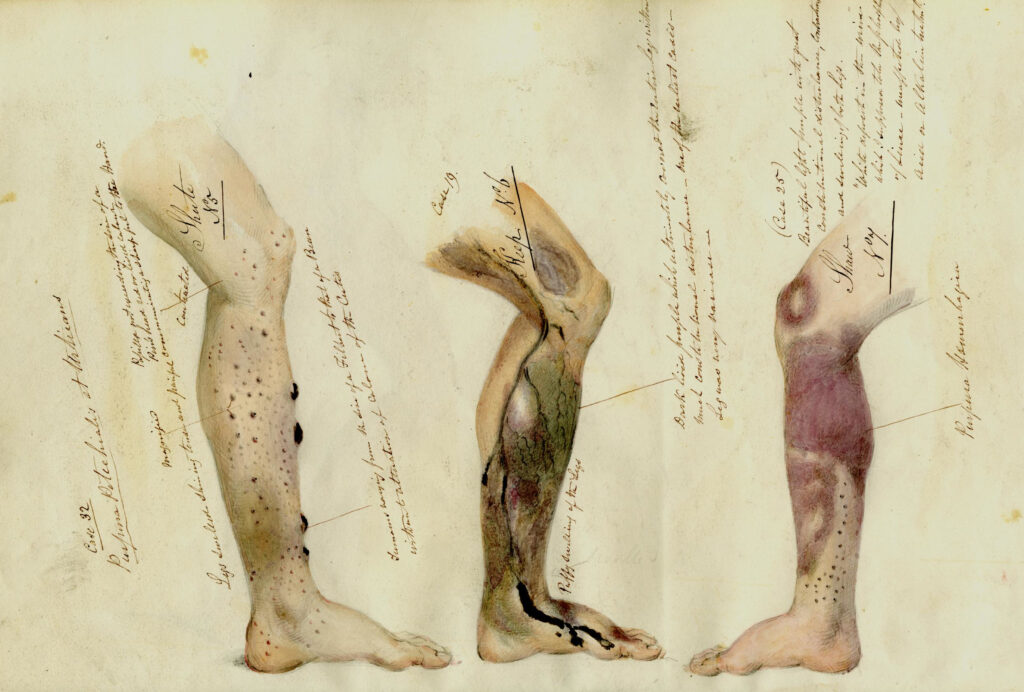
Recovery took time. “To our great mortification,” wrote Walter, “it was near twenty days after their landing, before the mortality was tolerably ceased; and for the first ten or twelve days, we buried rarely less than six each day, and many of those who survived recovered by very slow and insensible degrees.” Luckily, Juan Fernández Island turned out to be a veritable paradise, with acres of oats and clover, turnips and radishes, wild cresses, and sorrel, many of which are high in vitamin C. They also found a multitude of fish, including sea crayfish that Walter insisted weighed up to eight or nine pounds apiece. Anson was so giddy over the abundance of fresh food and crayfish dinners that he unpacked a stash of seeds he’d brought from home and planted them for future visitors to enjoy: lettuces, carrots, and the pits from peaches, apricots, and plums. The men stayed on the island for three months.
After nursing themselves back to health Anson and his men spent several months tooling around the South American coast, attacking Spanish towns and ships and managing, while close to land, to eat enough produce to keep scurvy at bay: there seemed to be a general acceptance among seafarers that fresh produce was helpful, though no one knew why. But the disease resurfaced during their Pacific crossing in the summer of 1742, killing up to five sailors a day; in mid-August they were forced to abandon the Gloucester because there weren’t enough men to repair it. (After transferring the sick onto the Centurion, the remainder of the sailors got wickedly drunk off the officers’ liquor cabinet and then torched the abandoned ship.)
Nonetheless, Anson somehow made it to Canton (now Guangzhou, China). There, despite the fact his total crew including new recruits numbered only 227 people, Anson decided to try for his mission’s second goal: finding and ambushing a Spanish treasure ship. In a nearly unbelievable stroke of luck the gamble paid off. On June 20, 1743, Anson captured a treasure galleon. In dramatic contrast to the numbers he’d lost to scurvy, only three of his men died in the fight.
Despite the horrendous loss of life during Anson’s voyage, the British navy considered the venture a success. Anson returned to England a rich and celebrated man and was appointed First Lord of the Admiralty in 1751. But despite his power and title he never lost sight of the price of his success: of the 2,000 men who set out with Anson, only a few hundred had made it home alive.
When reading such gruesome accounts, it’s difficult not to want to travel back in time, grab these men by the shoulders, and beg them to eat some lemons—or oranges, or any of the many other foods that contain vitamin C. This wouldn’t even have been a new idea: one of the strangest things about the history of scurvy (and many other vitamin-deficiency diseases) is that people kept figuring out cures and then forgetting them.
In 1535 the French explorer Jacques Cartier reported that after his ships had become locked in ice in the St. Lawrence River, his men were saved from scurvy by a special tea prepared by local Native Americans from the bark and leaves of a particular tree. In the 1500s and 1600s several ship captains suggested there might be a connection between fruits and vegetables and scurvy. In 1734 a Dutch physician named Johannes Bachstrom came up with the term antiscorbutic (“without scurvy”) and used it to describe fresh vegetables, thus becoming the first person known to suggest that scurvy might be a deficiency disease. Even Anson made a point of loading up on oranges whenever possible, and his chaplain, Walter, praised Juan Fernández Island for having “almost all the vegetables which are usually esteemed to be particularly adapted to the cure of those scorbutic disorders which are contracted by salt diet and long voyages.” Even though no one knew the cause of scurvy or what about these various foods made them antiscorbutic, many mariners recognized a connection between their diets and their health.
Today we know why fresh veggies stave off scurvy. Despite the chemical differences among vitamins, they all play crucial roles in our metabolism, a term that while often used in reference to our pants size, actually refers to all the series of chemical reactions that occur in our cells.
Though we rarely are aware of these reactions, our lives depend on them. Walking down the street requires them. Reading a book requires them. So does forming scar tissue, developing a baby, or creating any type of new cell. Chemical reactions build and break down muscle, regulate body temperature, filter toxins, excrete waste, support our immune systems, and affect (or indeed cause) our moods. They generate the energy we need to breathe and use the oxygen we inhale to pull energy from food. They allow us to feel and see and taste and touch and hear. Our metabolisms aren’t just a facet of our lives; they are our lives. Without these metabolic chemical reactions we would be as inert as stone.
The problem with many of these reactions, however, is that they’re way too slow: if they were left to run at their own speed, life would grind to a halt. Our bodies get around this issue with the help of enzymes, large protein molecules that kick-start and speed up specific chemical reactions, often making them occur millions of times faster than they would on their own. But our bodies sometimes need help making enzymes, and enzymes themselves sometimes need help doing their jobs. That’s where vitamins come in: two of their primary functions are to help our bodies make enzymes and to aid enzymes in their work. While enzymes speed up chemical reactions without being destroyed themselves, most vitamin-dependent reactions actually use up the vitamins. That’s why we need a continuous external supply.
It makes sense then that vitamin deficiencies cause problems because without adequate vitamins every enzymatic process that depends on those vitamins will come screeching to a stop. In the case of scurvy the issue is collagen, a primary structural protein in our muscle, skin, bones, blood vessels, cartilage, scars, and other connective tissues that makes up some 30% of the protein in the human body. Collagen holds our tissues together; the word itself is derived from the Greek word for glue. Without collagen our bodies would come apart from within—hence the hemorrhaging, broken bones, and loose teeth of scurvy. (Despite sailors’ testimonials, though, it is unlikely scurvy would cause any previously healed bones to actually dissolve. But, says Michael Levine, medical director of the Center for Bone Health at the Children’s Hospital of Philadelphia, scurvy does cause bone weakness that could contribute to fractures—which means that if a bone had been previously broken, the healed section might be particularly vulnerable to breaking again.) We make collagen from its precursor, procollagen, with the help of enzymes. But those enzymatic reactions can’t happen—and thus collagen cannot be formed—without vitamin C.
Early explorers didn’t know about collagen or enzymes. As for the era’s doctors and scientific thinkers, not only did they lack the analytical tools and chemical knowledge necessary to even conceive of a nutritional-deficiency disease, but many popular hypotheses about scurvy’s cause were still related to the ancient theory of the humours, including alkalinity, acidity, too much black bile, and blocked perspiration. Supposed triggers lacked even that medical grounding: according to author Frances Rachel Frankenburg they ranged from fatigue and depression to homesickness, contagion, seawater, damp air, copper pans, tobacco, hot climate, cold climate, rats, heredity, contagion, too much fresh fruit (whoops), too much exercise, too little exercise, sea air, salted meat, poor morals, and filth.
But even if the concept of vitamins had been familiar, vitamin C would be a tough one to figure out. Humans—along with guinea pigs, fruit bats, and several other simians—are the only mammals that can’t make their own vitamin C. For every other creature vitamin C is referred to as “ascorbic acid” (shorthand for antiscorbutic acid), and—since their bodies can produce it in sufficient quantities—it isn’t considered a vitamin at all.
It’s also not obvious where to find vitamin C. Cabbage and broccoli have a lot. Eggs and cheese don’t have any. There are large amounts in liver and kidneys but not in muscle meat. A half-cup of pears will give a woman about 4% of her daily recommended dietary allowance, but the same amount of kiwi will give her 111%.
These days we associate vitamin C with citrus fruits. That’s mainly because of the British navy, which, beginning in the 19th century, supplied its sailors with limes—chosen instead of lemons because Britain controlled colonies that grew limes (hence the nickname “limey” for British sailors). But this thriftiness came at a price: limes have only half as much vitamin C as lemons and oranges. Preparation matters, too. The proponents of “rob,” a popular treatment made from boiled-down citrus juice, had the right idea, except guess what? Vitamin C is destroyed by heat—not to mention cutting, bruising, exposure to air, and being cooked in copper pots.
As a result the confusion over scurvy was so great that even James Lind, the person who gets the most credit for establishing that citrus fruit cures scurvy, overlooked his own discovery.
Lind was a Scottish physician who served as a naval surgeon on the British ship the HMS Salisbury in 1747 and devised what is considered to be one of the world’s first controlled experiments. He took 12 sailors who were similarly sick with scurvy and divided them into six pairs. All the men ate the same food and lived in the same quarters on the ship; the only difference was their treatment. Lind gave each pair various daily doses of one of six supposed scurvy cures: a quart of hard cider, 25 drops of vitriol, two spoonfuls of vinegar, a half pint of seawater, two oranges and one lemon, and an “electuary”—a creative mix of garlic, mustard seed, balsam of Peru, dried radish root, and gum myrrh, shaped into a pasty concoction the size of a nutmeg. (Lest that treatment not sound random enough, those sailors also got barley water treated with tamarinds and an occasional laxative dose of cream of tartar.) With the exception of the citrus fruit, which ran out in less than a week, Lind administered the treatments for 14 days.
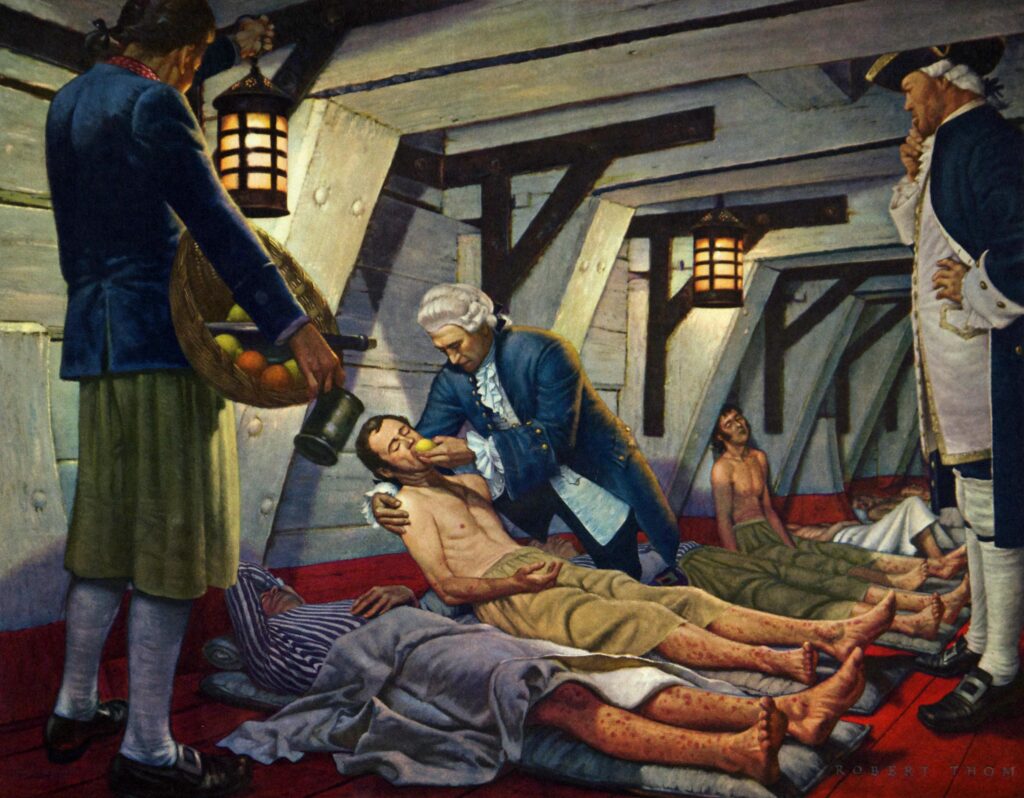
As the diversity of treatments indicates, Lind’s experiment had no foregone conclusion. Nonetheless, it didn’t take long for one treatment to emerge as better than the others: the men treated with citrus fruits recovered so thoroughly and rapidly that they helped Lind care for the other sailors. Because of this experiment Lind is often given historical credit for recognizing citrus as a definitive cure for scurvy. But that’s not what actually happened.
Instead, when Lind retired from the navy in 1748, he got to work on the first edition of a massive book called A Treatise of the Scurvy: Containing an Inquiry into the Nature, Causes, and Cure, of That Disease Together with a Critical and Chronological View of What Has Been Published on the Subject. True to its sweeping title, the book, which he dedicated to Anson, ended up being some 400 pages long. Lind described his crucial experiment in five paragraphs coming about 200 pages into the book, and condensed the key result into one seriously downplayed sentence: “As I shall have occasion elsewhere to take notice of the effects of other medicines in this disease, I shall here only observe that the results of all my experiments was, that oranges and lemons were the most effectual remedies for this distemper at sea.”
Lind wasn’t trying to bury the lead; he just didn’t recognize the significance of his results. Sure, the oranges and lemons had cured scurvy, but the sailors who got the cider seemed a little better, too. (This is plausible since the unrefined hard cider Lind distributed might have contained a little of the vitamin.) And so rather than dwell on citrus, Lind moved on to describe his own humour-inspired explanation of scurvy: that it was actually a digestive disease caused by blocked sweat glands.
Unfortunately, by the time Lind published the third edition of his book in 1772, he had completely lost sight of what we now consider his most important observations. While Lind did still think lemon juice might be effective against scurvy—he thought it might clear out the blocked sweat glands, especially if mixed with wine and sugar—he included so many disclaimers that his argument was hardly convincing. “I do not mean to say that lemon juice and wine are the only remedy for the scurvy,” he wrote. “This disease, like many others, may be cured by medicines of very different, and opposite qualities to each other, and to that of lemons.”
Nonetheless, progress was gradually made. It had to be: as the size of the world’s navies increased, the problem of scurvy only grew worse, and whichever nation could prevent scurvy would be guaranteed an enormous military advantage.
In 1795 a physician named Gilbert Blane convinced the British Royal Navy to issue some form of lemon juice to its sailors. His order may well have changed the course of history because it allowed Great Britain to successfully defend itself from a Napoleon-led invasion by setting up a blockade of the English Channel. This blockade, during which many ships spent months on the water without coming to port, went on for 20 years—a feat that scurvy would never have allowed.
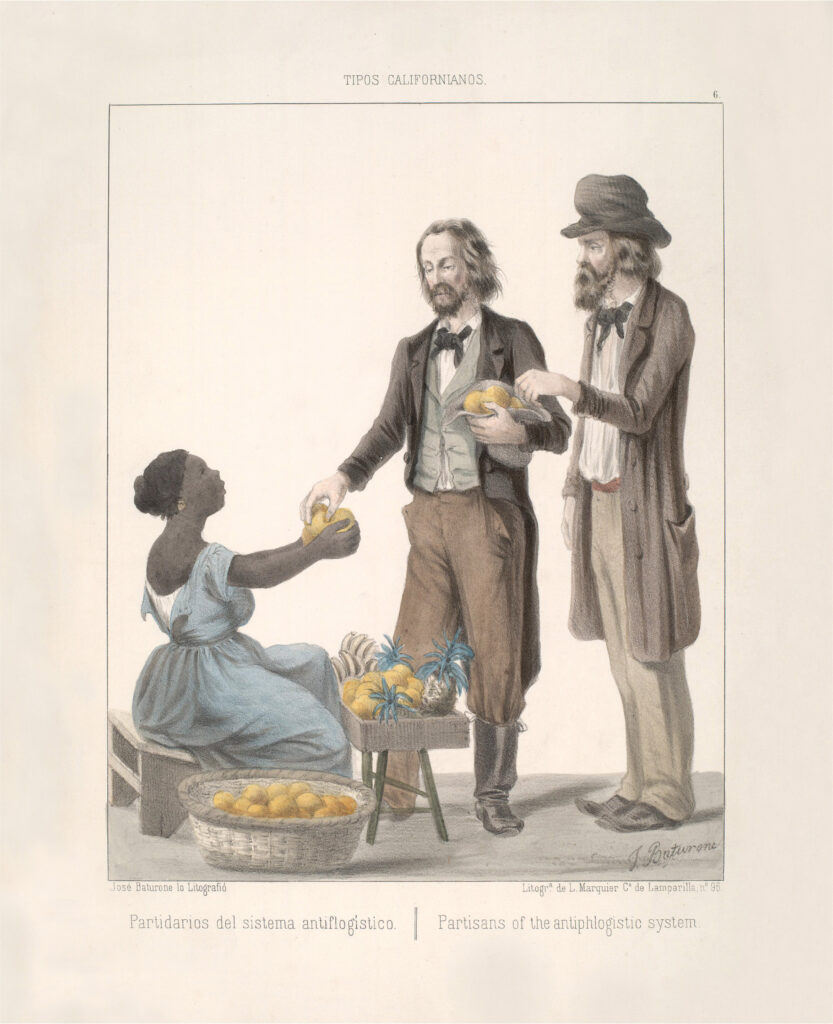
And yet no matter how many times the connection between scurvy and produce was demonstrated, people kept forgetting it; cures for scurvy continued to be lost and found and lost again. Scurvy appeared among members of the Arctic explorations of the 1820s and miners during the 1848–1850 American Gold Rush. Florence Nightingale reported entire shiploads of cabbage being tossed overboard during the Crimean War of 1853–1856 at the same time that soldiers were perishing from the disease. (The cabbage had been sent specifically to treat scurvy, but thanks to bureaucratic snafus no one had ordered it to be distributed in men’s rations.) The disease plagued prisons, refugee camps, and prisoners of war in the 20th century, and emerged among the babies of wealthy and educated Americans and Europeans in the late 1800s and early 1900s because of pasteurized cow’s milk. (The heat destroyed the vitamin C.)
Nearly a century would pass after the British blockade before anyone truly understood why fresh fruit or cabbage was effective in preventing scurvy. And even today the disease reappears wherever diets and circumstances allow. Doctors at the Baystate Medical Center in Springfield, Massachusetts, recently reported that between 2010 and 2015 they had found at least 30 cases in one of Springfield’s poorest neighborhoods. As is true with all vitamin-deficiency diseases, scurvy can never be eradicated; adequate nutrition is its only prevention and only cure.
Now looking back, it’s tempting to criticize our historical predecessors for not realizing (or remembering) what appears obvious. But history and science are rarely as straightforward as hindsight makes them seem, and the story of vitamins is no exception. The discovery of vitamins was not a moment but a process, a fascinating and often complicated journey in three parts. The first step on this path was the recognition and acceptance of the idea of nutritional-deficiency diseases. And the acceptance of that idea depended on two radical new concepts: that diet can have a direct effect on health and that sickness can be caused not just by the presence of something in food, like a germ or a toxin, but by a substance that is missing.

